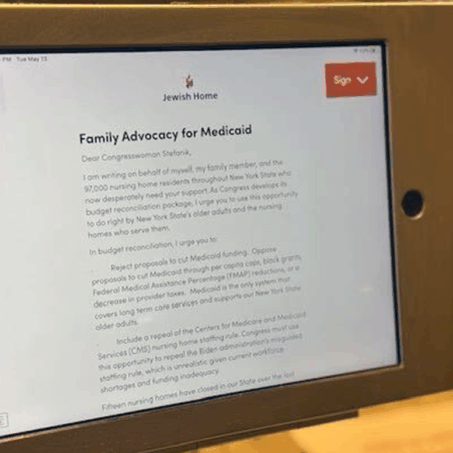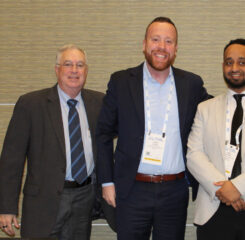Consistent and repeated communication on advocacy issues, particularly from constituents to elected officials, is critical to ensuring LeadingAge members’ ability to continue serving older adults. To ramp up participation among a vital audience–resident friends and family–in an ongoing campaign to boost state and federal contributions to Medicaid reimbursement rates, Mike King, CEO of The Jewish Home of Rochester, a LeadingAge New York member, turned to web-based technology solutions paired with existing digital visitor sign-in programs.
Why Casting a Wide Net for Advocacy Matters
“We’ve learned the squeaky wheel gets the attention,” King says, explaining his rationale for investing in the technology. “We’ve seen other organizations that advocated strongly [on their issues] have an impact” on legislators’ actions. Because “lack of adequate Medicaid funding in our nursing homes impacts all of us,” he says, “the rationale for all of us to participate in advocacy is clear.”
In 2024, The Jewish Home of Rochester switched modalities on its advocacy approach. Instead of asking friends and family members to sign advocacy letters printed on paper, The Jewish Home of Rochester implemented a digital approach that directs digital missives to state legislators and federal senators and representatives via a web-based platform. Noting that the “right kind of system, and information technology (IT) support” is needed, King tapped his tech team to build out the process.
How the Integration Works
The visitor login product (Envoy) that The Jewish Home of Rochester uses has custom screens at sign in, explains Travis Masonis, the community’s senior vice president and chief innovation officer. His team adds an additional screen with a specific digital advocacy letter (with content rotated on a regular basis) to their visitor log in system. Visitors who do not wish to sign a letter are able to cancel this additional screen and proceed with signing in.
As visitors sign in and enter their contact information, the software programs prefill visitors’ name and contact information fields in the advocacy letter, simplifying and reducing time spent on advocacy participation. At that point, Masonis says, the visitor needs only to read the letter, sign with their finger and click “next”–at which point a visitor badge is printed to allow for building entrance. “So from the visitor standpoint, it’s one extra screen that they just sign … and move on.” The signed letters are delivered electronically to a separate email box. King’s team prints them out on a weekly basis and mails them to the specific lawmaker.
Jewish Home of Rochester’s tech-supported friends and visitor advocacy mailings from December 2024 though late April 2025 have reached over 13,000 state and federal lawmakers. It’s a “dramatic increase,” King says, and an ongoing tactic supporting their overall commitment to raising awareness about Medicaid rates and funding support. “By getting the message out,” King believes, “we’ve had an impact.”

 Shutdown Week Three: Impact of Ongoing Closure on Affordable Housing
Shutdown Week Three: Impact of Ongoing Closure on Affordable Housing


